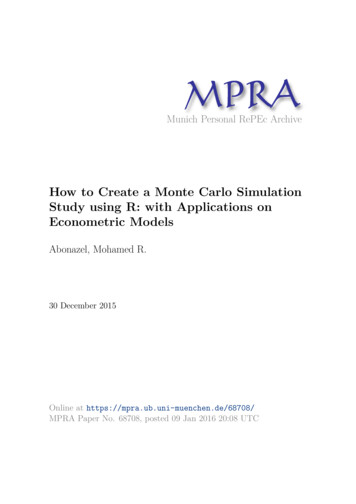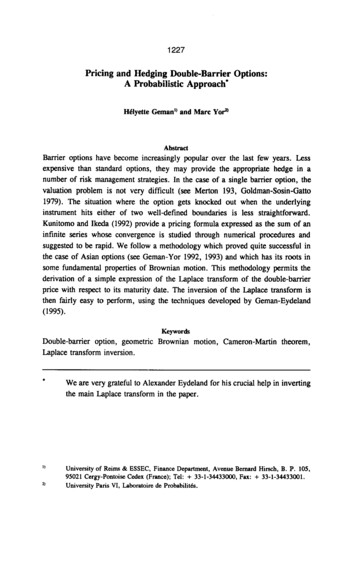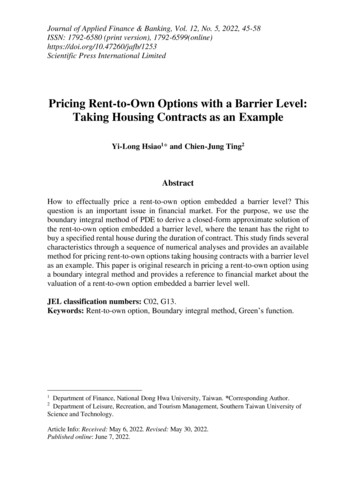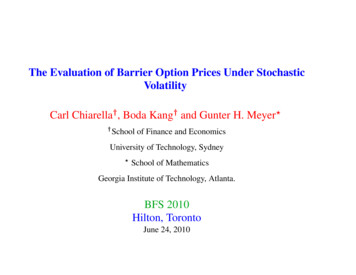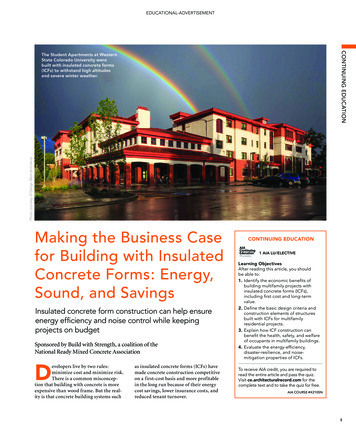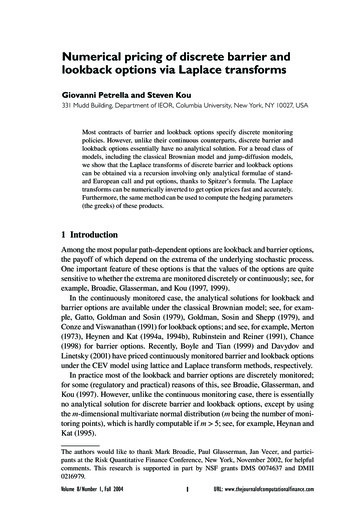
Transcription
U.U.D.M. Project Report 2011:5Pricing Barrier Options usingMonte Carlo MethodsBing Wang and Ling WangExamensarbete i matematik, 30 hpHandledare och examinator: Johan TyskMaj 2011Department of MathematicsUppsala University
AbstractBarrier options are cheaper than standard vanilla options, because a zero payoff mayoccur before expiry. They may match risk hedging needs more closely than ordinaryoptions, which make them particularly attractive to hedgers in the financial market. Thispaper analyzes the pricing of barrier options using Monte Carlo methods. Four variancereduction techniques are discussed and implemented in the pricing of barrier options. Wecompare numerical results for option prices from analytical formulas with Monte Carlosimulation where efficiency is improved by different variance reduction methods. Fromthe computational results, we find that the antithetic variates method substantiallyimproves the precision of Monte Carlo estimates. Our results also show that using theordinary put option as a control variate significantly reduces standard errors. Theconditional Monte Carlo and the combined conditional expectation and importancesampling method are found less attractive in our case.1
AcknowledgementsWe would like to thank our supervisor, Professor Johan Tysk, for his useful suggestionsand guidance throughout this study. In this master thesis we study the price estimation forbarrier options by Monte Carlo Simulations, using variance reduction methods. BingWang writes the theoretical background and mathematical concepts of barrier options, theMonte Carlo simulation and variance reduction techniques. Ling Wang contributes to thepaper by introducing and providing the Matlab algorithm and analyzes the computationalresults. We have shared hours of discussion concerning different problems and enjoyed agreat co-operation.2
Table of contentsAbstract . 1Acknowledgements . 21. Introduction . 42. Literature Review. 53. Financial Background . 63.1 Options. 63.2 Arbitrage and Portfolios . 73.3 Brownian Motion . 83.4 Black-Scholes Model . 93.5 Pricing Vanilla Options . 104. Barrier Options. 104.1 Exotic and Path-Dependent Options. 104.2 Barrier Options . 115. Monte Carlo Simulation. 145.1 Basic Concepts . 145.2 Monte Carlo Simulation for Option Payoffs . 156. Variance Reduction Techniques for Monte Carlo Simulation . 166.1 Antithetic Variates . 166.2 Control Variates . 176.3 Conditional Monte Carlo . 186.4 Importance Sampling . 197. Computational Results and Analysis . 238. Conclusions . 30References . 32Appendix . 343
1. IntroductionBarrier options are one of the most widely traded derivatives in the financial markets.They have special characteristics which distinguish them from ordinary options. Thepayoff of a barrier depends on the path of the underlying asset price. These options areactivated or expired when the underlying asset price either hits or does not hit a specifiedbarrier before expiry. One reason that an investor prefers a barrier option to an ordinaryvanilla option is that barrier options are generally cheaper than standard options. This isbecause the asset price has to cross a certain barrier for the option holder to receive thepayoff. The other reason is that barrier options may match risk hedging needs moreclosely than standard options.Various approaches for pricing barrier options have been developed. One such method isMonte Carlo simulation. Under the Black-Scholes model, barrier options can beconsidered that the asset price follows the Geometric Brownian Motion. Monte Carlosimulation has been proven to be an effective and simple tool in pricing options. Theefficiency and accuracy of estimating option prices can be improved by introducingvariance reduction techniques.In this present thesis, we concentrate on comparing numerical results for option pricesfrom analytical formulas with results of Monte Carlo simulations. To improve theefficiency, a variety of different variance reduction techniques will be considered.This paper is organized as follows. Section 2 is the literature review on barrier options,the Monte Carlo simulation and variance reduction methods. Section 3 covers thefundamental financial theory. This will include a discussion of the risk-neutral measure,the Black-Scholes model and the option valuation. Section 4 covers the concept andproperties of barrier options. The closed form formula for the selected barrier options willbe presented. The mathematical concepts and the fundamental theory of Monte Carlosimulation for option payoffs are introduced in Section 5. In Section 6 we price barrieroptions by Monte Carlo Methods. We introduce various variance reduction methods4
which are used to improve the efficiency and accuracy of the simulation. This willinclude antithetic variates, control variates, conditional Monte Carlo and the combinedconditional expectation and importance sampling method. Section 7 compares numericalresults obtained from analytical formula with the results of corresponding Monte Carlosimulations. Conclusions are presented in Section 8. Simulation coding is done in Matlab.Codes used for simulation can be found in the Appendix.2. Literature ReviewBlack and Scholes (1973) successfully derived the first closed form solution for Europeanoptions, under the assumption that the stock price follows a lognormal distribution.Merton (1973) provided the first analytical formula for a down and out barrier call option.This was then further extended for all types of standard barriers by Reiner and Rubinstein(1991).Boyle (1977) first introduced using Monte Carlo simulation to study option pricing,where the payoff was simulated for vanilla options. Hull and White (1987), Johnson andShanno (1987), Scott (1987), and Figlewski (1992) also used Monte Carlo simulation foranalyzing options. This was further extended by introducing variance reductiontechniques and Monte Carlo simulation was used for Asian options, Barrier options andAmerican options. Boyle (1977) used antithetic variates and control variates approachesto price European call options. Antithetic variates method was also considered byFishman and Huang (1983), Rubinstein, Samorodnitsky and Shaked (1985), Hull andWhite (1987), and Clewlow and Carverhill (1994). Kemna and Vorst (1990) applied thecontrol variates method in pricing Asian options. Broadie and Glasserman (1996)estimated price derivatives in a simulation framework by using control variates. Themethod was also employed by Clewlow and Carverhill (1994) and Carverhill and Pang(1995) to value options on coupon bonds. Boyle, Broadie and Glasserman (1997) derivedthe conditional expectation estimator for the price of a barrier option. Ross andShanthikumar applied the conditional expectation technique to barrier options. They alsocombined the conditional expectation and importance sampling estimators. The5
application of importance sampling in pricing barrier options was described by Boyle.Glasserman, Heidelberger and Shahabuddin (1999) applied the combination ofimportance sampling and stratified sampling in the Heath-Jarrow-Morton framework.Glasserman and Staum (2001) applied importance sampling in pricing barrier options.3. Financial Background3.1 OptionsDerivative securities are financial contracts, or financial instruments, whose values arederived from the value of underlying assets. The underlying asset can be a stock, a bond,a foreign currency, an index portfolio, or another derivative security. Derivatives can beused by individuals or financial institutions to hedge risks. There are many types ofderivatives such as options, forwards, futures and swaps.There are two basic kinds of options: call options and put options. A call option is acontract which gives the holder the right--but not the obligation--to buy the underlyingasset at a stated price on or before a stated date. On the contrary, a put option is a contractwhich gives the holder the right--but not the obligation--to sell an asset at a stated priceon or before a stated date. The stated price in the contract is called the strike price; thedate in the contract is called the maturity or expiry date. The premium is the price paidfor an option.In general, options are defined either as European or American. A European option canonly be exercised at the maturity date of the option, otherwise the option simply expires.An American option is more flexible: it can be exercised at any time up to and includingthe maturity date.Consider first a European call option with the strike K, the underlying asset’s price atmaturity ST and expiry date T, the call option’s payoff at maturity is given by:Payoff max 0, ST K ( ST K ) .6
Similarly, for a European put option with the strike K, the underlying asset’s price atmaturity ST and expiry date T;Payoff max 0, K ST ( K ST ) .We restrict our studies in this paper to put options, the results for call options are similar.3.2 Arbitrage and PortfoliosAn arbitrage opportunity implies that we make profits without taking any risk.Opportunities for arbitrage are very short-lived as many traders will take advantage ofsuch opportunities and eventually cause the prices to adjust until arbitrage no longerexists. A common principle in the option pricing theory states that there are no arbitrageopportunities or the market is arbitrage-free.The idea of pricing options with no arbitrage is to construct a portfolio of the stock and ariskless investment to replicate the payoff of the option. The portfolio’s value must, bythe absence of arbitrage, equal the price of the option at all times. We form the portfolioas follows. It consists of two instruments: mt shares of stock and bt units of bond.Therefore the value of the portfolio at time t isVt mt S t bt Bt .With continuous time models, a portfolio consisting of (mt, bt) is called self-financing ifVt followstt00Vt V0 mu dS u bu dBu .The change in Vt is only due to changes in the price of assets and the portfolio has noadditional cash inflow or outflow during the time period (0, T). Proofs for the followingdefinitions and theorems can be found in Klebaner (2005).Definition 1 A claim with a payoff X is said to be replicable if there exists a selffinancing portfolio Vt 0 and X Vt.The above expressions lead to an important insight in option pricing--the risk-neutralvaluation principle.7
Theorem 1 Suppose there is a probability measure Q, such that the discounted stockprocess Zt St/Bt is a Q-martingale. Then for any replicating trading strategy, thediscounted value process Vt/Bt is also a Q-martingale.This probability measure Q is called risk-neutral probability measure or an equivalentmartingale measure. We denote the original probability measure by P.Definition 2 Two probability measures P and Q are called equivalent if they have samenull sets, that is, for any set A with P(A) 0 we also have Q(A) 0 and vice versa.Theorem 2 (First Fundamental Theorem) A market model does not have arbitrageopportunities if and only if there exists a probability measure Q, equivalent to P, suchthat the discounted stock process Zt St/Bt is Q-martingale.A market model is complete if any claim is replicable and the martingale probabilitymeasure Q is unique.Theorem 3 The price of a claim with payoff X at time t 0 is given by1EQ X .BTEQ denotes that the expected value of the option at date t is taken under the equivalentmartingale probabilities. Theorem 3 states that the value of an option at date 0 is thediscounted expected value of the payoff. This theorem is central to pricing options.3.3 Brownian MotionTo model the price process of the underlying asset, we have to choose a stochasticprocess that satisfies its properties. Financial mathematicians usually consider the price ofthe underlying asset is described by Brownian Motion.8
A stochastic process W is called a Brownian Motion Process if the following propertieshold: Normal increments: Wt Ws has normal distribution with mean 0 and variance t – s. Independent increments: Wt Ws is independent of the past. Continuity of paths: W t is a continuous function of t.A Generalized Brownian Motion for a variable S can be defined as dS t adt bdWt ,where a and b are constants. In order to describe the price process of a stock, thegeneralized Brownian motion can be modified to satisfy the basic properties of the stockprice, so we havedS t S t dt S t dWt .The above equation is also known as Geometric Brownian Motion, where µ and σ areconstant parameters referred to as drift the volatility3.4 Black-Scholes ModelRecall that we are working under the assumption of risk neutrality, where no arbitrageopportunities exist. The basic benchmark model for pricing security derivatives is theBlack-Scholes model. It was developed by Black and Scholes (1973) and Merton (1973).The Black-Scholes model consists of two assets with dynamics. First we assume that thestock price is given bydS t S t dt S t dWt .where µ is the drift, σ is the volatility, Wt is the standard Brownian Motion under theprobability measure P. The bond price Bt isdBt rBt dt.where r is the riskless interest rate.9
Since the Black-Scholes Model is a complete market model and has no arbitrageopportunities, there exists a unique equivalent martingale measure Q. Under the Qmeasure, we have the following stochastic differential equation for St instead:dS t rS t dt S t dWt .where Wt is a standard Brownian motion under the risk-neutral probability measure Q.The solution of the above equation is given by:1S t S 0 exp((r 2 )t Wt ) .23.5 Pricing Vanilla OptionsOptions with no special features are referred to vanilla options. The Black-Scholesformula for a European call option was derived by Black and Scholes (1973).C 0 S 0 N (h) e rt KN (h T ), 1 where h ln S 0 K r 2 T and N is the cumulative normal distribution2 function.An extension of the Black-Scholes formula is the put-call parity. From this equation wecan easily calculate the price of the put option, knowing the price of the call option.S t Pt C t Ke r (T t ) ,where Ct is the call price and Pt is the put price.4. Barrier Options4.1 Exotic and Path-Dependent OptionsExotic options refer to options that depend on the behavior of the price process duringtheir lifetimes. Unlike a vanilla option, the payoff depends not only on the underlyingasset price at expiration, but also on its whole path. There are many types of exoticoptions, such as Asian options, Barrier options and Lookback options. Each has their ownunique characteristics. Exotic options in most cases offer cheaper premium prices than10
standard vanilla options. Path-dependent options are heavily monitored before expiration.They are of particular interest in learning and testing numerical methods.4.2 Barrier OptionsA barrier option is a type of path-dependent option where the payoff is determined bywhether or not the price of the stock crosses a certain level Sb during its life. There aretwo general types of barrier options, ‘in’ and ‘out’ options. In knock-out options, thecontract is canceled if the barrier is crossed throughout the whole life. Knock-in optionson the other hand are activated only if the barrier is crossed. The relationship between thebarrier Sb and the current asset price S0 indicates whether the option is an up or downoption. If Sb S0, we have an up option; if Sb S0, we have a down option. Combiningthese features with the payoffs of call and put options, we can define an array of barrieroptions.For example, a down-and-out put option is a put option that becomes worthless if theasset price falls below the barrier Sb. Therefore the risk for the option writer is reduced. Itis reasonable to expect that a down-and-out put option is cheaper than a vanilla one, sinceit may expire worthless if the barrier is hit while the vanilla option would have paid off.For a given set of parameters, we can combine an in and an out option of the same type toreplicate an ordinary vanilla option. This is due to the fact that when one option getsknocked out, the other is knocked in. Therefore holding both a down-and-out and adown-and-in put option is equivalent to holding a vanilla put option. The parityrelationship can be described as:P Pdi Pdo ,where P is the price of the vanilla put, and Pdi is the price for the down-and-in option andPdo is the price of the down-and-out options.It is worth pointing out the relationship between the option price and the barrier level. Fora knock-out option, increasing the absolute difference between the barrier level and the11
initial spot price has a positive effect on the option value, since the probability ofknocking out tends to zero as the absolute difference increases. The value of the optionconverges to the value of an ordinary vanilla option. It is opposite for the knock-in option:increasing the absolute difference reduces the option value since the probability ofknocking in approaches zero.Barrier options are very sensitive to volatility. For knock-out options, increased volatilitymakes knock-out more probable and therefore leads to a reduction on the option value.The price of knock-in options increases with increased volatility, since knock-in becomesmore probable.The barrier might be monitored continuously or discretely. Analytical pricing formulasare available for certain continuously monitored barrier options. Consider a down-andout put with strike price K, a barrier Sb, expiring in T. We have the following formulaP Ke rT N d 4 N (d 2 ) a N (d 7 ) N d 5 S 0 N d 3 N (d1 ) b N d 8 N d 6 ,where 1 2 r / 2 Sa b S0 Sb b S0 1 2 r / 2andd1 d2 d3 d4 log( S 0 / K ) r 2 / 2 T T log( S 0 / K ) r 2 / 2 T T log( S 0 / S b ) r 2 / 2 T T log( S 0 / S b ) r 2 / 2 T T12
d5 d6 d7 d8 log( S 0 / S b ) r 2 / 2 T T log( S 0 / S b ) r 2 / 2 T T log( S 0 K / S b2 ) r 2 / 2 T T log( S 0 K / S b2 ) r 2 / 2 T T.The discrete price converges to the continuous price as the monitoring frequencyincreases, suggesting that we can adjust the continuous formula to obtain anapproximation to the discrete monitoring price. The idea is using the analytical pricingformula of continuous barrier options but shifting the barrier to correct for discretemonitoring. The shift is determined by the monitoring frequency t , the asset volatility ,and a constant 0.5826 .1Theorem 4 Let Vm ( Sb ) be the price of a discretely monitored knock-in or knock-out downcall or up put with barrier Sb. Let V ( Sb ) be the price of the corresponding continuouslymonitored barrier option. Then Vm S b V S b e t o 1 , m where the sign depends on the option type. We take the minus sign for a down put, andthe plus sign for an up put. The term derives from the Riemann zeta function : 1 2 2 1.46042 0.5826.Thus, to use the continuous price as an approximation to the discrete price, we shouldcorrect the barrier as follows:S b S b e 0.5826 t,1For more detailed information, readers are referred to Mark Broadie, Paul Glasserman.1997. A Continuity correction for Discrete Barrier Options.13
Discrete monitoring lowers the probability of crossing the barrier compared withcontinuous barrier monitoring. We should expect that the price for a discretely monitoreddown-and-out option is increased, since hitting the barrier is less likely.5. Monte Carlo Simulation5.1 Basic ConceptsSimulation techniques are important tools to deal with path dependent payoffs ordistributions with no analytic expression. Monte Carlo simulation may be used forpricing derivative securities, estimating value at risk and simulating hedging strategies.The relative ease of use and flexibility are its main advantages. The disadvantage ofMonte Carlo simulation is its computational burden, which may be partially solved byvariance reduction methods. We use Monte Carlo simulation for simulating option pricevalues and compare them with results obtained from analytical formulas. In this section,we will go through the main concept of Monte Carlo simulation.Suppose we want to estimate some , E g (X ) .where g(X) is an arbitrary function. We can randomly generate n independent samplevalues X1, X2, ., Xn from the probability density function f(x). The estimator of is givenby: By the law of large numbers, we obtain1 n g ( X i ).n i 1 1 ng ( X i ) E ( g ( X )) as n or as n i 1n . That is, this estimate converges to the actual value as the number of observationsincreases. The sample variance can be written as:s2 21 ng ( X i ) ˆ . n 1 i 114
The central limit theorem ensures that the distribution of ˆ sntends to the standardnormal distribution when n is large enough. For large n we have ss 1 .P z z 1 1 nn 22 We may try to measure the quality of our estimator by considering the standard errorsn . Clearly, one way to improve the accuracy of the estimate is to increase thenumber n. We would need to run 10,000 simulations trials to receive a reduction of thestandard deviation by a factor of 100. Another approach is to reduce the size of s directly.This may be accomplished by using variance reduction techniques.5.2 Monte Carlo Simulation for Option PayoffsWhen we use the Monte Carlo simulation to price an option, the approach can besummarized into three steps. Simulate n sample paths of the underlying asset price over the time interval. Calculate the payoff of the option for each path. Average the discounted payoffs over sample paths.The first step in pricing barrier options using Monte Carlo methods is to simulate thesample paths of the underlying stock price. In vanilla options, there is really no need forpath generation, only the price of the underlying asset at maturity is of concern. Butbarrier options are path-dependent options--the payoff is determined by whether or notthe price of the asset hits a certain barrier during the life of the option. Due to this pathdependency, simulation of the entire price evolution is necessary. To simulate a samplepath, we have to choose a stochastic differential equation describing the dynamics of theprice. We consider the price of the underlying asset is described by a GeometricBrownian Motion:dS t S t dt S t dWt . 1 Using Euler scheme, we haveS t t (1 t )S t S t t .15
By applying Ito’s lemma, we receive the following expression: 2 1d log S t ( 2 )dt dWt .2St is log-normally distributed and thereby we haveE log( S (t ) / S (0)) vtVar log( S (t ) / S (0)) 2 tE S (t ) / S (0) e t Var S (t ) / S (0) e 2 t e t 1 .2where v 2 2 . Integrate equation (2) yielding:tS t S 0 exp(vt dW ( )).0Let us discretize the time interval (0, T) with a time step t . From the equation above andthe properties of the standard Wiener process, we obtainS t t S t exp(v t t ). 3 where N(0,1) is a standard normal random variable. Based on equation (3), we cantherefore generate sample paths for the asset price.6. Variance Reduction Techniques for Monte Carlo SimulationIn this section, we price barrier options with the help of variance reduction techniques.We have seen in section 4.2 how the analytical formula for continuous monitoring can beadjusted to reflect discrete monitoring. The analytical result will be used to check theresult of Monte Carlo simulation. We can see that variance reduction techniques indeedimprove the efficiency of Monte Carlo simulation.6.1 Antithetic VariatesIn Monte Carlo simulations, increasing the sample size is computationally costly. So wemay focus on reducing the sample variance. The method of antithetic variates works byreplacing independent X’s with negatively correlated random variables.16
Suppose we want to estimate E(g(X1, X2, ., Xn)), where X1, X2, ., Xn are independentrandom variables. Let Y1 and Y2 be random variables with the same distribution as g(X1,X2, ., Xn). ThenVar(Y1 Y2Var(Y1 ) Var Y2 2Cov Y1 , Y2 ) .24It is obvious that the variance will be reduced if we have the two samples negativelycorrelated.Following the idea outlined above, we generate a random draw from the N(0, 1)distribution. By symmetry Z -Z where Z N(0, 1), we set Y1 from X1, . Xn N(0, 1)and Y2 from –X1, . –Xn N(0, 1). Thus, we generate a pair of random variables (Y1, Y2)and the estimator by the antithetic variates method is 1 n g ( X i ) g ( X i ). n i 12where Xi and -Xi are the so called antithetic variates. If g is a monotonically increasing ormonotonically decreasing function, then Cov g ( X ), g ( X ) 0. Therefore, we canachieve a variance reduction by using this method.6.2 Control VariatesThe control variates method is another way to reduce the variance and generate moreaccurate results. Suppose we want to estimate E X and there is another randomvariable Y, which is correlated with X in some sense, with a known expected value E(Y).The variable Y is called the control variate. We can define a random variable Z asZ X c Y E Y ,where c . Clearly we have E Z E ( X ) c( E (Y ) E (Y )) E ( X ) , hence we canapply Monte Carlo simulation to Z instead of E(X). We also haveVar Z Var X cY Var X 2cCov X , Y c 2Var Y .17
As we want to minimize the variance we have to choose the optimal value of c. Simplecalculus givescmin Cov X , Y .Var Y In practice, Cov(X,Y) and Var(Y) have to be estimated using Monte Carlo simulation,since they are usually unknown.By using the control variates method, we can use Monte Carlo simulation to price theoptions with no closed-form formulas. If we want to price a down-and-out put option, asuitable control variate could be a plain vanilla put option. Both its expected value andvariance can easily be calculated. We can get the put value through the Black-Scholesformula.To estimate the covariance between the down and out put price and the plain vanilla putprice, we have to run a set of pilot replications. The value of c that minimizes thevariance can be calculated using the formula mentioned above. We can then obtain thebarrier price using the previously obtained value of c.6.3 Conditional Monte CarloConsider a down-and-in put option whose price is Pdi. The conditional Monte Carlo isbased on the following idea: we shall stop the simulation once the stock price hits thebarrier and then use the Black-Scholes formula to compute the price of a put optioninstead of simulating the price path until expiry. We reduce the variance since we aredoing part of the work analytically and leaving less to be done through Monte Carlosimulation. Because of the following parity relationship,Pdo P Pdi .we can easily get the price of the corresponding knock-out option. Assume the stockprices are observed at discrete time steps:S S1 , S 2 ,.,S M .18
Based on this path, the price of the option is the discounted expected payoff Pdi e rT E I ( S )( K S M ) ,where the indicator function I is 1 if S j S b for some jI (S ) 0 otherwise .Now let j* be the index of the time instant at which the stock crossed the barrier. Theoption is activated at time j * t , and we can treat it as a vanilla put from now on.Conditional on the crossing time t * j * t and the price S j* , we may use the BlackScholes formula to estimate the put option. If the stock price does n
vanilla option is that barrier options are generally cheaper than standard options. This is because the asset price has to cross a certain barrier for the option holder to receive the payoff. The other reason is that barrier options may match risk hedging needs more closely than standard options. Various approaches for pricing barrier options have been developed. One such method is Monte Carlo .
